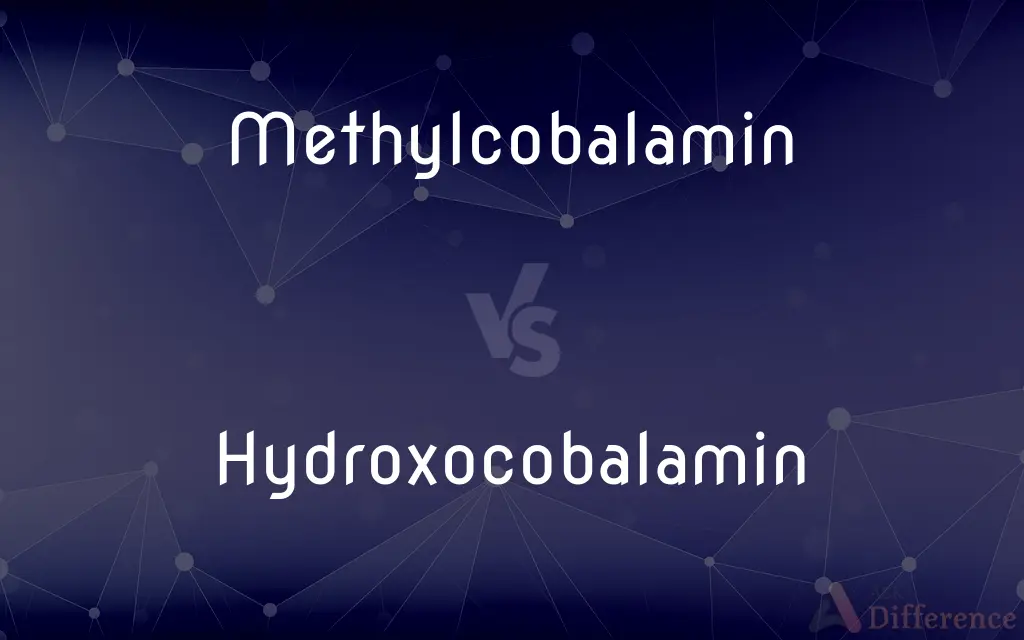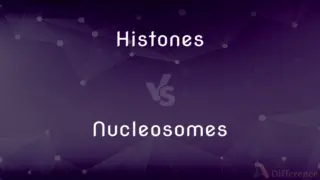Methylcobalamin vs. Hydroxocobalamin — What's the Difference?
By Tayyaba Rehman — Published on October 24, 2023
Methylcobalamin and Hydroxocobalamin are both forms of vitamin B12. While Methylcobalamin is a coenzyme form, Hydroxocobalamin is commonly used to treat B12 deficiencies and cyanide poisoning.

Difference Between Methylcobalamin and Hydroxocobalamin
Table of Contents
ADVERTISEMENT
Key Differences
Natural Occurrence: Methylcobalamin is a naturally occurring form of vitamin B12 found in foods and the human body. In contrast, Hydroxocobalamin is a non-active form produced by bacteria and converted in the body to active forms.
Medical Application: Hydroxocobalamin is often preferred in clinical settings, especially for B12 deficiency injections. It has a longer half-life than Methylcobalamin, making it a stable choice for treatments. Moreover, Hydroxocobalamin is effective against cyanide poisoning, as it binds to cyanide, forming cyanocobalamin, which is excreted in urine.
Molecular Structure: The primary difference in molecular structure is the group attached to the cobalt atom in the B12 molecule. Methylcobalamin contains a methyl group, while Hydroxocobalamin contains a hydroxyl group.
Bioavailability: Both are biologically active, but Methylcobalamin is seen as the most bioavailable, as it's a coenzyme form of B12. It's ready to interact with the enzyme methionine synthase in the body.
Neurological Health: Methylcobalamin is often highlighted for its potential benefits in neurological health. It's believed to be more effective than other B12 forms in protecting and regenerating nerves.
ADVERTISEMENT
Comparison Chart
Natural Occurrence
Naturally in foods and the human body
Produced by bacteria
Medical Application
General B12 supplementation
B12 deficiency injections & cyanide poisoning treatment
Molecular Attachment
Methyl group
Hydroxyl group
Bioavailability
High (coenzyme form)
Converted in the body to active forms
Noted Health Benefit
Neurological health
Cyanide poisoning treatment
Compare with Definitions
Methylcobalamin
The coenzyme form of vitamin B12.
Methylcobalamin is essential for DNA synthesis in the body.
Hydroxocobalamin
Preferred for long-term B12 deficiency treatments.
Its stability and longer half-life make Hydroxocobalamin a top choice for doctors.
Methylcobalamin
A naturally occurring form of vitamin B12.
Many vegans take Methylcobalamin supplements to prevent B12 deficiency.
Hydroxocobalamin
A non-active form of vitamin B12 produced by bacteria.
Hydroxocobalamin injections are administered to treat B12 deficiencies.
Methylcobalamin
Supports nerve health and regeneration.
Neurologists sometimes recommend Methylcobalamin for nerve-related issues.
Hydroxocobalamin
Binds to cyanide to form cyanocobalamin.
Hydroxocobalamin's ability to neutralize cyanide is a unique and essential medical property.
Methylcobalamin
Directly involved in homocysteine metabolism.
Elevated homocysteine levels can be managed with Methylcobalamin intake.
Hydroxocobalamin
Effective against cyanide poisoning.
In cases of cyanide exposure, Hydroxocobalamin can be a lifesaver.
Methylcobalamin
Ready for immediate use in the body.
Because of its bioactive nature, Methylcobalamin starts working quickly in the system.
Hydroxocobalamin
Converted into active B12 forms in the body.
Once administered, Hydroxocobalamin transforms into usable B12 forms.
Methylcobalamin
A cobalamin (form of vitamin B12) used to treat neuropathies.
Hydroxocobalamin
(vitamin) A natural analog of vitamin B12, a basic member of the cobalamin family of compounds, with an intense red color.
Common Curiosities
Which form of B12 is naturally found in the human body?
Methylcobalamin is the naturally occurring form.
Can Hydroxocobalamin be used to treat cyanide poisoning?
Yes, Hydroxocobalamin is effective against cyanide poisoning.
What's the primary molecular difference between the two?
Methylcobalamin has a methyl group, while Hydroxocobalamin has a hydroxyl group.
Can both forms be found in supplements?
Yes, both can be found, but Methylcobalamin is more common in over-the-counter supplements.
Why might one prefer Methylcobalamin for nerve health?
Methylcobalamin is believed to be effective in nerve protection and regeneration.
Which form has a longer half-life?
Hydroxocobalamin has a longer half-life.
Is one form better absorbed than the other?
Both are well-absorbed, but Methylcobalamin is readily usable in the body.
Can vegetarians get sufficient Methylcobalamin from their diet?
It's challenging, as B12 is primarily in animal products, so supplements might be needed.
Which form of B12 is a coenzyme in the body?
Methylcobalamin is the coenzyme form.
Which form is commonly used in B12 injections for deficiency?
Hydroxocobalamin is often used for B12 deficiency injections.
How does Hydroxocobalamin treat cyanide poisoning?
It binds with cyanide to form cyanocobalamin, which is excreted.
Why might a doctor choose Hydroxocobalamin injections over other forms?
Due to its stability, longer half-life, and effective conversion in the body.
Are both forms of B12 bioactive?
Methylcobalamin is bioactive, while Hydroxocobalamin is converted in the body.
How is Hydroxocobalamin produced?
It's produced by bacteria.
Can Methylcobalamin support brain health?
Yes, it's often associated with potential brain health benefits.
Share Your Discovery

Previous Comparison
Histones vs. Nucleosomes
Next Comparison
Committed Fixed Costs vs. Discretionary Fixed CostsAuthor Spotlight
Written by
Tayyaba RehmanTayyaba Rehman is a distinguished writer, currently serving as a primary contributor to askdifference.com. As a researcher in semantics and etymology, Tayyaba's passion for the complexity of languages and their distinctions has found a perfect home on the platform. Tayyaba delves into the intricacies of language, distinguishing between commonly confused words and phrases, thereby providing clarity for readers worldwide.












































